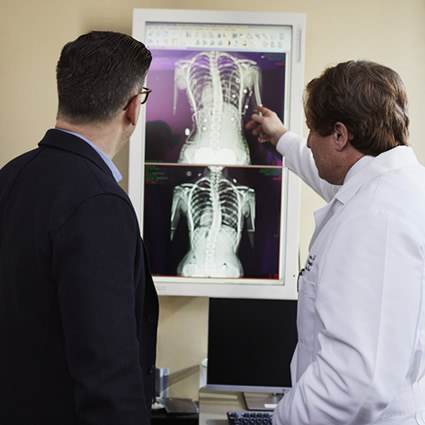Treatment for Scoliosis
What’s all the talk about scoliosis? What does scoliosis really mean?
Can chiropractors provide treatment for scoliosis?
 At Complete Care Health we’re going to try and answer the scoliosis questions.
At Complete Care Health we’re going to try and answer the scoliosis questions.
The word scoliosis is just another “Umbrella term”. Umbrella terms are commonly used to give a general non-specific meaning or diagnosis of a condition. We avoid general “umbrella terms” like “disc bulge”, “sciatica” and “scoliosis”, instead we use evidence based medicine to give our patients diagnoses specific terms.
Scoliosis means a curve in the back?
When most people talk about scoliosis they think of a curve in their back and that’s correct. Scoliosis is a curve in the back as seen in the (coronal) plane, the postero-anterior view or simply as seen from behind. Well humans aren’t perfectly symmetrical so it’s normal to have small asymmetrical differences in our spine.
Evidence based literature tends to suggest that scoliosis below 35 degrees is not significantly linked with back pain and is only clinically significant if above 35 degrees and progressing. This is most commonly seen in adolescents / teenagers. If “true” scoliosis is detected either surgery, bracing or careful monitoring is required at regular intervals over a timeframe until the scoliosis is deemed to be non-progressing.
More FAQs
There are several types of scoliosis and various diseases and skeletal anomalies link with it:
Congenital scoliosis (examples)
- Hemi-vertebra – Being born with bones in the spine that are wedge shaped (wedge shaped vertebra), or hemi-vertebra are particularly noted in the mid-back (thoracic spine) and can offset the normal spinal curvature. Congenital scoliosis can cause the deviations in coronal spinal curve development, leading to a scoliosis above 35 degrees.
- Leg Length discrepancy – One limb shorter in length than the other can lead to scoliosis but only if significant differences are apparent. Leg length discrepancies may affect twisting of the pelvis, lower back and mid back.
- Klippel-Feil Syndrome (Non-descent of the scapula during development)
- Idiopathic scoliosis -The most common Scoliosis and has no known cause or definitive link to back pain.
- Developmental scoliosis – May be due to an inherited disease, such as those listed below.
Examples include:- Marfan syndrome (Connective tissue disorder)
- Ehlers-Danlos syndrome (connective tissue disorder)
- Muscular dystrophy (progressive skeletal muscle weakness)
- Cerebral palsy (Damage to motor control centers in the developing brain)
- Neurofibromatosis (Nerve tissue tumors)
Symptoms of Scoliosis
- An elevated shoulder (one higher than the other)
- Leg length inequality
- Winging scapula (One side of the rib cage appears higher than the other
- Pelvic unleveling /antalgia
It is incorrect to say that chiropractors can treat scoliosis, instead chiropractors can help correct and restore joint dysfunction in non-scoliotic joints but not spinal curvatures like scoliosis. Chiropractors will make a professional decision to provide treatment to patients with scoliosis but not specifically to treat scoliosis. Patients with true progressing scoliosis above 35 degrees need medical evaluation and possible surgery or bracing.
Want To Learn More?
Call our office today and schedule a consultaion with our team to learn more about scoliosis treatment at Complete Care Health.
CONTACT US »

